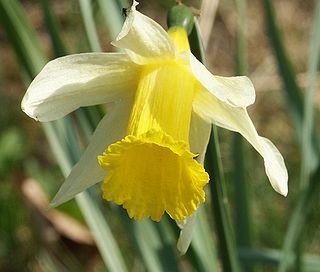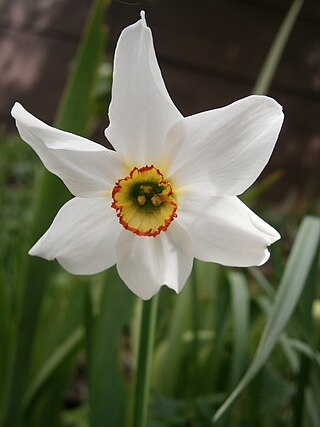
In Greek mythology, Narcissus was a hunter from Thespiae in Boeotia who was known for his beauty which was noticed by all, regardless of gender. According to the best known version of the story, by Ovid, Narcissus rejected all advances, eventually falling in love with a reflection in a pool of water, tragically not realizing its similarity, entranced by it. In some versions, he beat his breast purple in agony at being kept apart from this reflected love, and in his place sprouted a flower bearing his name.

In Greek mythology, Echo was an Oread who resided on Mount Cithaeron. Zeus loved consorting with beautiful nymphs and often visited them on Earth. Eventually, Zeus's wife, Hera, became suspicious, and came from Mount Olympus in an attempt to catch Zeus with the nymphs. Echo, by trying to protect Zeus, endured Hera's wrath, and Hera made her only able to speak the last words spoken to her. So when Echo met Narcissus and fell in love with him, she was unable to tell him how she felt and was forced to watch him as he fell in love with himself.

Black Narcissus is a 1947 British psychological drama film jointly written, directed and produced by Michael Powell and Emeric Pressburger, and starring Deborah Kerr, Sabu, David Farrar, and Flora Robson, and featuring Esmond Knight, Jean Simmons, and Kathleen Byron.
In Greek mythology, Liriope or Leiriope is a Boeotian naiad of Thespiae, who was probably the daughter of one of the Boeotian or Phocian river gods. Liriope was raped by the river-god Cephissus, who was himself the son of Pontus and Thalassa, and bore his son Narcissus.

Narcissus is a genus of predominantly spring flowering perennial plants of the amaryllis family, Amaryllidaceae. Various common names including daffodil, narcissus and jonquil, are used to describe all or some members of the genus. Narcissus has conspicuous flowers with six petal-like tepals surmounted by a cup- or trumpet-shaped corona. The flowers are generally white and yellow, with either uniform or contrasting coloured tepals and corona.
During World War II, Operation Narcissus was a raid by forty members of the Special Air Service on a lighthouse on the southeast coast of Sicily. The team landed on 10 July 1943 with the mission of capturing the lighthouse and the surrounding high ground.

The British film-making partnership of Michael Powell (1905–1990) and Emeric Pressburger (1902–1988)—together often known as The Archers, the name of their production company—made a series of influential films in the 1940s and 1950s. Their collaborations—24 films between 1939 and 1972—were mainly derived from original stories by Pressburger with the script written by both Pressburger and Powell. Powell did most of the directing while Pressburger did most of the work of the producer and also assisted with the editing, especially the way the music was used. Unusually, the pair shared a writer-director-producer credit for most of their films. The best-known of these are The Life and Death of Colonel Blimp (1943), A Canterbury Tale (1944), I Know Where I'm Going! (1945), A Matter of Life and Death (1946), Black Narcissus (1947), The Red Shoes (1948), and The Tales of Hoffmann (1951).

Metamorphosis of Narcissus (1937) is an oil-on-canvas painting by the Spanish surrealist Salvador Dalí. Originally titled Métamorphose de Narcisse, This painting is from Dalí's paranoiac-critical period and depicts his interpretation of the Greek myth of Narcissus. Dalí began his painting in the spring of 1937 while in Zürs, in the Austrian Alps.

Narcissus pseudonarcissus, commonly named the wild daffodil or Lent lily, is a perennial flowering plant.

Narcissus poeticus, the poet's daffodil, poet's narcissus, nargis, pheasant's eye, findern flower or pinkster lily, was one of the first daffodils to be cultivated, and is frequently identified as the narcissus of ancient times. It is also often associated with the Greek legend of Narcissus. It is the type species of the genus Narcissus and is widely naturalised in North America.

Narcissus Hut is an alpine hut located in the Central Highlands of Tasmania. It was first built in 1935 and rebuilt in 1963 after being burnt down. The hut was renovated in 2015, when a new sheltered deck was constructed on the eastern side, along with paintwork.

Saint Narcissus of Jerusalem was an early patriarch of Jerusalem. He is venerated as a saint by both the Western and Eastern Churches. In the Roman Catholic Church, his feast day is celebrated on October 29, while in the Eastern Orthodox Church it is celebrated on August 7.
Narcissus of Athens is numbered among the Seventy Disciples. Along with the Apostles Urban of Macedonia, Stachys, Ampliatus, Apelles of Heraklion and Aristobulus of Britannia he assisted Saint Andrew. The Apostle Philip ordained St. Narcissus bishop of Athens. His feast day is October 31.

Narcissus is a painting by the Italian Baroque master Caravaggio, painted circa 1597–1599. It is housed in the Galleria Nazionale d'Arte Antica in Rome.

Narcissus jonquilla, commonly known as jonquil or rush daffodil, is a bulbous flowering plant, a species of the genus Narcissus (daffodil) that is native to Spain and Portugal but has now become naturalised in many other regions: France, Italy, Turkey, the former Yugoslavia, Madeira, British Columbia in Canada, Utah, Illinois, Minnesota, Ohio, and the southeastern United States from Texas to Maryland.

Ungiminorine is an acetylcholinesterase inhibitor isolated from Narcissus.

The taxonomy of Narcissus is complex, and still not fully resolved. Known to the ancients, the genus name appears in Graeco-Roman literature, although their interest was as much medicinal as botanical. It is unclear which species the ancients were familiar with. Although frequently mentioned in Mediaeval and Renaissance texts it was not formally described till the work of Linnaeus in 1753. By 1789 it had been grouped into a family (Narcissi) but shortly thereafter this was renamed Amaryllideae, from which comes the modern placement within Amaryllidaceae, although for a while it was considered part of Liliaceae.

HMS Narcissus was the lead ship of the Royal Navy Narcissus-class 32-gun fifth-rate frigates, launched in 1801. She participated in the War of 1812.
Black Narcissus is a drama television serial, based on the 1939 novel by Rumer Godden. The series features one of the final performances of Diana Rigg, who died in September 2020. The drama premiered on November 23, 2020, on FX in the US, and on December 27, 2020, on BBC One in the UK.













